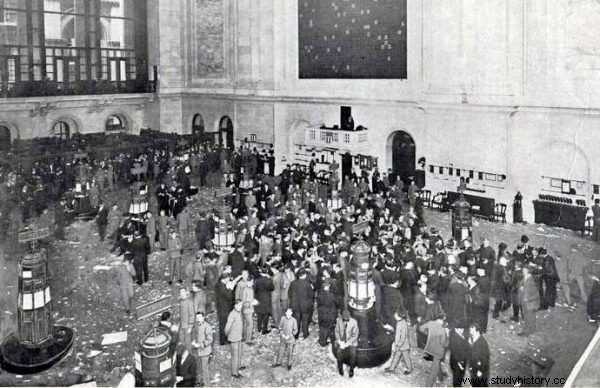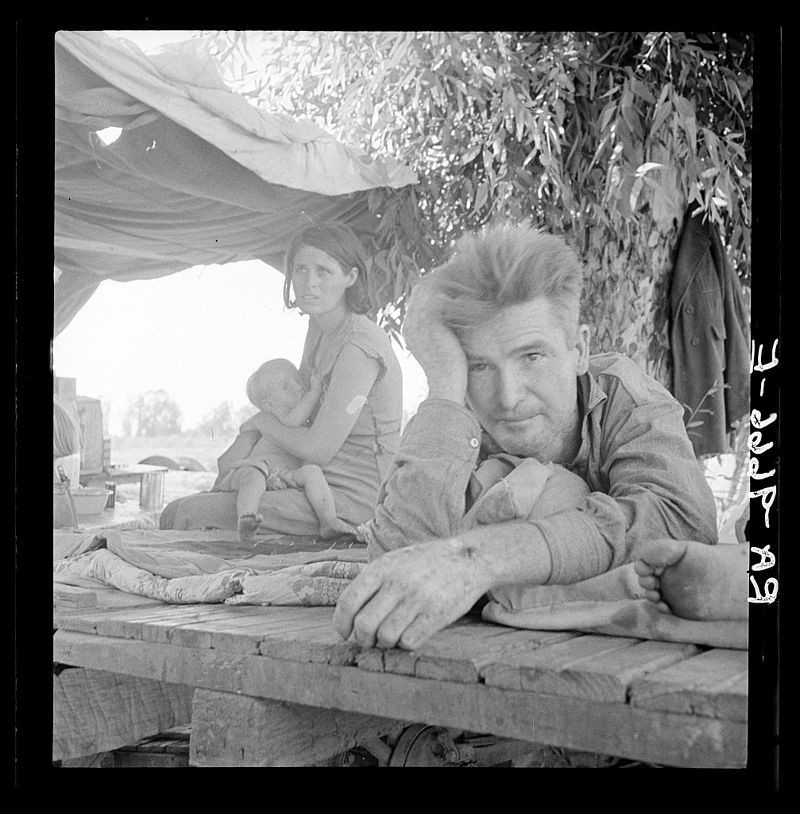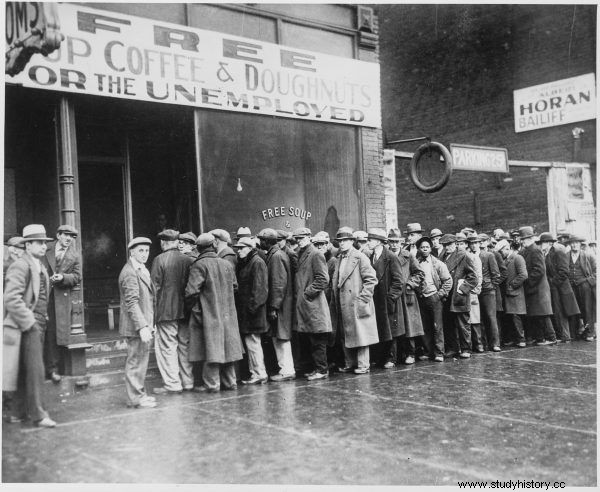Millions of unemployed. Hundreds of thousands of homeless people. A wave of suicides and rape. Where it began - in the US - the Great Depression spared almost no one. How bad was it?
It all started innocently. Shortly after the end of the First World War, the world economy gained a new impetus for development - the time of peace. In the 1920s, only a few economies, such as the German, Austrian and Turkish economies, had to deal with the effects of the recent war. Several other countries successfully replicated their GDP, led by the United States.
The American policy of non-interference in external affairs and the lack of an immediate threat of hostilities made the citizens of the United States look to the future with high hopes. In the period from 1918 to 1929, American society grew rich with great impetus. However, it should be remembered that we are talking mainly about urban centers. Meanwhile, the percentage of rural residents was still close to 45% of the population.
Hundreds of thousands of homeless
There is a paradox under the term Great Depression. We associate it with the stock market crash, and in fact, only 10% of the American public participated in stock market speculation. Some sources mention that there were fewer than 3 million brokerage accounts open when the country's population was then one hundred and twenty million.

The Great Depression began with the stock market crash. Perhaps because relatively few Americans followed its changes, initially the signals of the impending catastrophe were downplayed? The photo still shows the calm New York Stock Exchange in 1908.
An indirect effect of the events on the American stock exchanges was the collapse of several thousand banks, in which millions of citizens were accumulating savings. Between 1930 and 1931, more than three thousand banks with deposits totaling up to $ 2.5 billion went bankrupt. It was an unimaginable amount for the average American, whose annual earnings were about 1,500 dollars.
Already in the first years of the Great Depression, 600,000 people lost their roof over their heads and several states and smaller towns were liquidated. In New York alone, 800,000 people remained unemployed, at the mercy of state institutions or private charities. According to the Polish Americanist, Lubomir Zyblikiewicz, "New York City authorities' spending on aid increased from 9 million in 1930 to 58 million USD in 1932, and the amount of private charity of New Yorkers from 4.5 million to 21 million USD."
The stock market crash and the wave of bankruptcies in October 1929 actually affected only a fraction of the American economy. At the same time, however, the majority of society was not prepared for the further development of events. Along with the shaking of the banking system and subsequent bankruptcies, problems arose with the payment of salaries to employees.
Subsequent plants reduced employment, such as the GM and Ford plants, which further reduced workers' salaries due to the recession. This state of affairs lasted until the end of the 1930s. As Zyblikiewicz points out, this had one more surprising consequence, because ... "the recession made it easier to switch production to war".
A nation on the move
The cities were hit hardest by the crisis. Does that mean life was easier in the American countryside? Certainly not:poverty was common there. This is evidenced by the low level of electrification. As late as 1934, as many as 80% of the inhabitants did not have access to electricity . It was only the actions taken by Roosevelt in the 1930s that began to civilize large parts of the country. Previously, various interest groups opposed this.
A separate problem, even more important than capital markets, was overproduction. American companies produced more goods than they could sell on the domestic market. This led to more layoffs. As a result, within a dozen or so months, more than ten million people, whose situation was catastrophic due to malnutrition, remained unemployed. This mainly concerned the south of the country.

Thousands of banks went bankrupt during the crisis.
Lots of people looking for jobs and shelter found their way. It is a population of itinerant workers, or so-called hobos , increased to nearly 700,000. They often traveled stowaways on freight trains or simply walked along the railway lines. This life, according to the American historian Tom H. Watkins, also chose up to 200,000 children. During the Great Depression, the work of juveniles aged 14-18 was quite common, so it is no wonder that they too took the railroad.
Another researcher of this period, Errol Lincoln Uys, writes that up to a quarter of a million children were on the streets at that time. Often they had the blessing of their parents, who themselves were unable to provide them with care and food. They were both boys and girls, initially enjoying the romanticism of "adventures", later broken by fatigue and hunger. "Sick and suffering from chronic malnutrition, seems to exist solely because of her nails that he has a habit of biting "- this is how the sociologist Thomas Minehan described one of the young wanderers, fifteen-year-old Kay.
Suicides and ... anti-Semites
Tim Cresswell estimates that the percentage of girls and women among minors is hobo ranged between 10 and 25%. It is difficult to know their fate, as there are not many memories left, only observations of witnesses or modest press clippings. Most of them fled from poverty and hopelessness. These women have often lived in prostitution and many have experienced rape.

In Oklahoma, drought worsened the already difficult conditions. The photo shows a family of refugees looking for a job in a cotton field.
The condition of society is evidenced by the fact that during the crisis the fertility rate decreased by nearly 20%. On the other hand, the number of suicides has increased. In total, forty thousand people took their lives during the Great Depression.
For some time, the living conditions of the population continued to deteriorate. No wonder the search for the guilty has begun. For a large part of society, Jews, of course, became such. "Anti-Semitism during the Crisis and in the years leading up to World War II reached a level unprecedented either before or after," comments researcher Barbara S. Burstin.
Organizations appeared in the USA that saw Jews as a threat to the USA and, more broadly, to Christianity. There have been cases of attacking them in the streets and desecrating synagogues. The situation was made even worse by Hitler's rise to power - his ideas were accepted and disseminated in the USA. It got so that fears of Jews were expressed by representatives of all strata of society, such as Henry Ford. The statistics speak for themselves. In 1938, 41% of Americans thought Jews had too much power in the US and 20% supported their removal outside the country.

Hundreds of thousands of people found themselves unemployed and without a roof over their heads. Primitive shacks, providing temporary shelter for the homeless, were even built in Manhattan.
Though the plight of many Americans has become dire, the incumbent president, Herbert Hoover, has long missed the looming defeat on the land. He also did not take sufficiently decisive steps to remedy it. It did not take long for the citizens to respond. The 1932 election brought a decisive victory for Franklin Delano Roosevelt.
How many people need help?
The new president, in a sense, was forced to intervene in the economy to a great extent in order to lead the United States out of the crisis. His predecessor also did not avoid moves of this type, but it was the New Deal introduced by Roosevelt who was accused of socialist inclinations. However, a number of necessary reforms were introduced, for example, in 1938 the work of minors was limited and standardized.
There is no doubt that the leader realized that the Great Depression was not just a temporary collapse. He realized the seriousness of the situation. After all, the so-called "poor old people" at one point made up a third of the nation! In 1937, Roosevelt described them as chronically people "poorly living, poorly dressed and poorly fed" . And he tried to help them a bit in the following years.
First of all, the president established two government agencies to fight the crisis:the National Reconstruction Administration (NRA) and the Public Works Administration (PWA). He was not very fortunate enough to appoint those in charge:he put General Hugh "Iron Pants" Johnson at the head of the NRA, and he brought Harold Ickes to the PWA. As noted by Jean Edward Smith, author of Roosevelt's new biography entitled "FDR" , these were personalities whose cooperation is difficult to imagine:
For Johnson, the old cavalryman, each endeavor was a breakneck charge towards the enemy ranks. Ickes, on the other hand, was pathologically wary. He believed that the public works program was not about quick, but prudent spending. Maniacally stingy, he personally delved into the smallest details of each project and spent a trace of $ 110 million in PWA money in 1933.
Despite these personal disagreements, the New Deal, which soon came into force, changed the vision of the country and the relationship between the citizen and the federal authority. First of all, the government decided to provide people with jobs. And at all costs.

Millions of people have been hit by unemployment. Many relied on help from charities and government programs. The photo shows a line of people waiting for free meals in Illinois.
A job from the president
For example, to help people during the winter, the president allocated an additional $ 400 million to find temporary work for four million people . This figure alone shows the scale of the problems that the state has faced. As Smith tells in the book "FDR. Franklin Delano Roosevelt ” , one of the president's closest advisers, Harry Hopkins, was able to work miracles with the money:
Hopkins provided 800,000 jobs in ten days , by mid-December 2,600,000, and at the beginning of January more than 4,000,000. P WA paid the applicable minimum wage for activities that did not require qualifications and the work was seasonal.
Before it ceased to exist in April 1934, it pumped almost a billion dollars into the ailing economy. Eighty percent of that amount went directly to workers' salaries, and most of the remaining money was spent on equipment and materials. The management of the entire project took up less than 2% […].

Harry Hopkins (right) was one of President Roosevelt's closest advisers (left). He also became one of the architects of the New Deal.
It is hard to find a better example of activities that have been realistically reflected in the everyday life of average citizens. As a result of this one initiative taken by Roosevelt, nearly 800,000 roads were commissioned and several thousand schools were renovated. Time has shown that most of the buildings built at that time served until the end of the 20th century.
The 1930s exposed the poverty and poverty of a country that was previously set as a paradise on earth. Glaring social inequalities and the neglect of previous ruling groups have come to light. Roosevelt took power in a country whose society was largely still alive in the 19th century. The village had no access to electricity or radio. There were many illiterate people in the less wealthy states. The crisis has only deepened these already distinct social divisions. They lasted for the next decades, the effects of which are still visible today.
Bibliography:
- Encyclopaedia of the Great Depression , ed. Robert S. McElvaine, Macmillan Reference 2003.
- Murray N. Rothbard, America's Great Depression , Ludwig von Mises Institute 2010.
- Jean Edward Smith, FDR. Franklin Delano Roosevelt , Napoleon V 2017.
- Tom H. Watkins, The Great Depression. America in the 1930s , Brown and Company 1993.
- Lubomir Zyblikiewicz, USA , Trio 2004.
